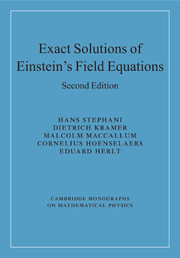38 - The interconnections between the main classification schemes
from Part V - Tables
Published online by Cambridge University Press: 10 November 2009
Summary
Introduction
As already pointed out in Chapter 1, the solutions of Einstein's field equations could be (and have been) classified according to (at least) four main classification schemes, namely with respect to symmetry groups, Petrov types, energy-momentum tensors, and special vector and tensor fields. Whereas the first two schemes have been used in extenso in this book, the others played only a secondary role, and the connections between Petrov types and groups of motions were also treated only occasionally.
This last chapter is devoted to the interconnection of the first three of the classification schemes mentioned above. It consists mainly of tables. §38.2 gives the (far from complete) classification of the algebraically special solutions in terms of symmetry groups. §38.3 contains tables, wherein the solutions (and their status of existence and/or knowledge) are tabulated by combinations of energy-momentum tensors, Petrov types and groups of motion. In the tables the following symbols are used:
S: some special solutions are known A: all solutions are known
∄: does not exist
Th., Ch. and Tab. are abbreviations for ‘Theorem’, ‘Chapter’ and ‘Table’ respectively.
For perfect fluid solutions, the connection between the kinematical properties of the four-velocity (see §6.1) and groups of motions was discussed e.g. by Ehlers (1961) and Wainwright (1979).
- Type
- Chapter
- Information
- Exact Solutions of Einstein's Field Equations , pp. 605 - 614Publisher: Cambridge University PressPrint publication year: 2003



